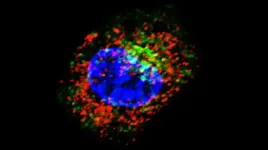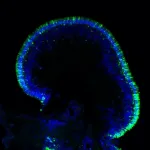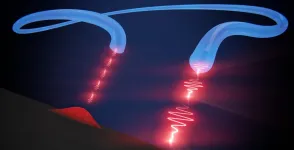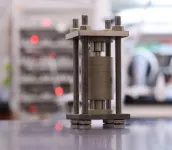Genetic analysis of symptoms yields new insights into PTSD
2021-01-28
(Press-News.org) Attempts to identify the genetic causes of neuropsychiatric diseases such as post-traumatic stress disorder (PTSD) through large-scale genome-wide analyses have yielded thousands of potential links. The challenge is further complicated by the wide range of symptoms exhibited by those who have PTSD. For instance, does extreme arousal, anger, or irritation experienced by some have the same genetic basis as the tendency to re-experience traumatic events, another symptom of the disorder?
A new study led by researchers at Yale and the University of California-San Diego (UCSD) provides answers to some of these questions and uncovers intriguing genetic similarities between PTSD and other mental health disorders such as anxiety, bipolar disorder, and schizophrenia.
The findings also suggest that existing drugs commonly used for other disorders might be modified to help treat individual symptoms of multiple disorders.
"The complexity is still there, but this study helped us chip away at it," said co-senior author Joel Gelernter, the Foundations Fund Professor of Psychiatry and professor of genetics and neurobiology at Yale.
The study was published Jan. 28 in the journal Nature Genetics.
For the study, the researchers analyzed the complete genomes of more than 250,000 participants in the Million Veteran Program, a national research program of the U.S. Veterans Administration that studies how genes, lifestyle, and military experiences affect the health and illness of military veterans. Among those participants were approximately 36,000 diagnosed with PTSD.
But instead of looking just for gene variants shared by PTSD patients, they also searched for variants that have been linked to three kinds of clinical symptoms that are experienced, to varying degrees, by those diagnosed with the disorder. These symptom groups, or "subdomains," include the re-experience of a traumatic event, hyperarousal or acute anger and irritability, and the avoidance of people or subjects that might be related to past trauma.
While the researchers found underlying genetic commonalities among all three symptom groups, they also discovered specific variants linked to only one or two of the symptoms.
"We found a remarkably high degree of genetic relatedness between these three symptom subdomains. But we also wouldn't expect them to be genetically identical, and they are not," Gelernter said. "We found biological support for different clinical presentations of PTSD."
The research also showed that some these variants found in subgroups of patient symptoms are also linked to other disorders such as major depression. The results suggest drugs used to treat other disorders might also help treat of PTSD.
"Our research pointed to some medications that are currently marketed for other disease states and could be repurposed for PTSD," said co-senior author Murray Stein, Distinguished Professor of Psychiatry and Public Health at UC-San Diego.
Intriguingly, some of the variants linked to all PTSD symptoms have been associated with other neuropsychiatric disorders. For instance, PTSD-associated variants of the gene MAD1L1, which helps regulate cell cycling, have also been linked to schizophrenia and bipolar disorder.
"These observations, and the recent finding of GWS [genomewide-significant] association with anxiety suggest that MAD1L1 may be a general risk factor for psychopathology," the authors write.
INFORMATION:
ELSE PRESS RELEASES FROM THIS DATE:
2021-01-28
Washington, DC - January 28, 2021 - Self swabs and caregiver swabs are effective at detecting multiple pathogens and are just as accurate as those taken by healthcare workers, according to a team of Australian researchers. The research appears in the Journal of Clinical Microbiology, a publication of the American Society for Microbiology.
"Across the range of pathogens and swab types, there was high agreement between results from self- or caregiver swabs and those performed by a healthcare worker, even when different sites were swabbed (e.g. nasopharyngeal vs. nasal)," said principal investigator Joshua Osowicki, BMedSci, MBBS, FRACP, a Pediatric Infectious Diseases physician in the Murdoch Children's Research Institute's ...
2021-01-28
Despite long-standing ideas about the importance of thumb evolution in tool use and development, questions remain about exactly when human-like manual dexterity and efficient thumb use arose--and which hominin species was the first to have this ability. Now, researchers who've analyzed the biomechanics and efficiency of the thumb across different fossil human species using virtual muscle modeling have new insight into when these abilities first arose and what they've meant for the development of more complex human culture. The findings, appearing January 28 in the journal Current Biology, suggest that a fundamental aspect of human thumb opposition first appeared approximately 2 million years ago and was not found ...
2021-01-28
What makes one person drive above the speed limit while another navigates steadily in the right lane? What motivates someone to leave a job with a steady paycheck to launch their own business while the other sticks to one employer for an entire career?
"People have different tendencies to engage in behavior that risks their health or that involve uncertainties about the future," says Gideon Nave, an assistant professor of marketing in Penn's Wharton School.
Yet explaining the origin of those tendencies, both in the genome and in the brain, has been challenging for researchers, partly because previous studies on ...
2021-01-28
ANN ARBOR, Michigan -- It was an unexpected discovery that started with an analysis of more than 1,000 genes. The question: why game-changing cancer immunotherapy treatments work for only a fraction of patients.
The analysis shone a light on one that popped up repeatedly in patients and mouse models that did not respond to immune checkpoint therapy: stanniocalcin-1, a glycoprotein whose role in both tumors and immunology is largely unknown.
By following the trail from this surprising thread, a University of Michigan Rogel Cancer team uncovered how stanniocalcin-1, or STC1, works inside the cell to block a cellular "eat-me" signal that typically triggers the immune system to produce T cells to fight the tumor. The findings, published in ...
2021-01-28
Scientists at the National Eye Institute (NEI) have developed a promising gene therapy strategy for a rare disease that causes severe vision loss in childhood. A form of Leber congenital amaurosis, the disease is caused by autosomal-dominant mutations in the CRX gene, which are challenging to treat with gene therapy. The scientists tested their approach using lab-made retinal tissues built from patient cells, called retinal organoids. This approach, which involved adding copies of the normal gene under its native control mechanism, partially restored CRX function. The study report appears today in Stem ...
2021-01-28
In early October 2019, when an unknown caller rang EPFL professor Johan Gaume's cell phone, he could hardly have imagined that he was about to confront one of the greatest mysteries in Soviet history. At the other end of the line, a journalist from The New York Times asked for his expert insight into a tragedy that had occurred 60 years earlier in Russia's northern Ural Mountains - one that has since come to be known as the Dyatlov Pass Incident. Gaume, head of EPFL's Snow and Avalanche Simulation Laboratory (SLAB) and visiting fellow at the WSL Institute for Snow and Avalanche Research SLF, had never heard ...
2021-01-28
Researchers at the University of Basel and Ruhr University Bochum have developed a source of single photons that can produce billions of these quantum particles per second. With its record-breaking efficiency, the photon source represents a new and powerful building-block for quantum technologies.
Quantum cryptography promises absolutely secure communications. A key component here are strings of single photons. Information can be stored in the quantum states of these light particles and transmitted over long distances. In the future, remote quantum processors will communicate with each other via single photons. And perhaps the processor itself will use photons as quantum bits for computing.
A basic prerequisite for such applications, however, is an efficient source ...
2021-01-28
Using X-ray tomography, a research team has observed the internal evolution of the materials inside solid-state lithium batteries as they were charged and discharged. Detailed three-dimensional information from the research could help improve the reliability and performance of the batteries, which use solid materials to replace the flammable liquid electrolytes in existing lithium-ion batteries.
The operando synchrotron X-ray computed microtomography imaging revealed how the dynamic changes of electrode materials at lithium/solid-electrolyte interfaces determine the behavior of solid-state batteries. The researchers found that battery operation caused voids to form ...
2021-01-28
Science is society's best method for understanding the world, yet many people in the field are unhappy with the way it works. Rules and procedures meant to promote innovative research can have perverse side-effects that harm both science and scientists. One of these - the 'priority rule' - rewards scientists who make discoveries with prestige, prizes and better career opportunities, depriving the runners-up of similar perks. Researchers at University of Technology Eindhoven (TU/e) and the Arizona State University in the US have developed a new model to better understand this rule, and see if current reforms to improve the system actually make sense. Their study was published in Nature Human Behaviour.
"Over the past decade, there have been growing concerns that something ...
2021-01-28
What The Study Did: This study finds that being a health care worker isn't associated with poorer outcomes among patients hospitalized with COVID-19.
Authors: Nauzer Forbes, M.D., M.Sc., of the University of Calgary in Canada, is the corresponding author.
To access the embargoed study: Visit our For The Media website at this link https://media.jamanetwork.com/
(doi:10.1001/jamanetworkopen.2020.35699)
Editor's Note: The article includes conflict of interest disclosures. Please see the article for additional information, ...
LAST 30 PRESS RELEASES:
[Press-News.org] Genetic analysis of symptoms yields new insights into PTSD





